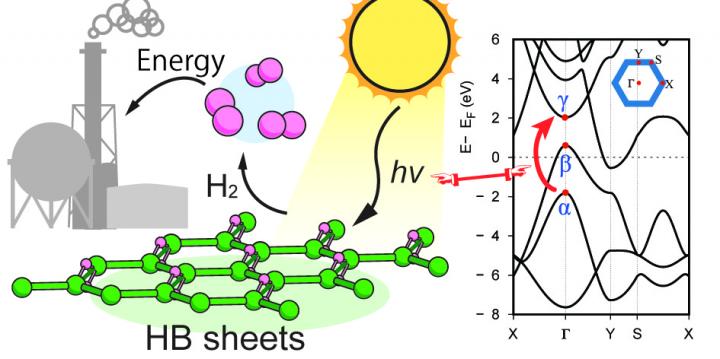Hydrogen boride nanosheets: A promising material for hydrogen carrier

The hydrogen storage and release capacity of HB sheets is exceptionally high due to their two-dimensional nature and unique electronic band structure. Credit: Nature Communications
Innovative nanosheets made from equal parts of hydrogen and boron have a greater capacity to store and release hydrogen compared with conventional metal-based materials.
This finding by researchers at Tokyo Institute of Technology (Tokyo Tech), the University of Tsukuba, Kochi University of Technology and the University of Tokyo reinforces the view that hydrogen boride nanosheets (HB sheets) could go beyond graphene as a nano-sized multifunctional material.
Their study, published in Nature Communications, found that hydrogen can be released in significant amounts (up to eight weight percent) from HB sheets under ultraviolet light, even under mild conditions — that is, at ambient room temperature and pressure.
Such an easy-to-handle setup opens up possibilities for HB sheets to be utilized as highly efficient hydrogen carriers, which are expected to become increasingly in demand as a clean energy source in the coming decades.
When HB sheets burst onto the scene in 2017, scientists recognized they could become an exciting new material for energy, catalysis and environmental applications. The breakthrough research garnered plaudits for its creative approach to materials design. A review article published in Chem in 2018 hailed the successful realization of HB sheets as “an exquisite example of human ingenuity at the pinnacle of innovative synthetic chemistry.”
HB sheets are expected to be applied for light-weight, light-responsive, and safe hydrogen carrier. Currently, HB sheets are only responsive to ultra-violet light, thus, the visible-light sensitivity is important for their industrial application.
Also, refilling of hydrogen remains a key challenge in developing sustainable, viable hydrogen storage solutions. To address this issue, Miyauchi explains his team is investigating the visible-light sensitivity, rechargeability, and long-term durability of HB sheets.
“Cost reduction of the starting materials — magnesium diboride — for HB sheets will be another important factor,” he adds.
The cross-institutional study showcases the predictive power of first-principles calculations[2] in materials science, namely as a way of investigating the mechanism of hydrogen release.
###
Technical terms
[1] hydrogen boride nanosheets: Two-dimensional materials derived from magnesium diboride (MgB2) that were first reported by researchers in Japan in 2017. The nanosheets exhibit extraordinary electronic and mechanical properties in addition to hydrogen storage capacity.
[2] First-principles calculations: Referring to a way of calculating mechanical, electronic or other properties of a given material based on the laws of quantum mechanics, which can lead to useful, predictive results prior to experimentation.
Media Contact
All latest news from the category: Materials Sciences
Materials management deals with the research, development, manufacturing and processing of raw and industrial materials. Key aspects here are biological and medical issues, which play an increasingly important role in this field.
innovations-report offers in-depth articles related to the development and application of materials and the structure and properties of new materials.
Newest articles

Eruption of mega-magnetic star lights up nearby galaxy
Thanks to ESA satellites, an international team including UNIGE researchers has detected a giant eruption coming from a magnetar, an extremely magnetic neutron star. While ESA’s satellite INTEGRAL was observing…

Solving the riddle of the sphingolipids in coronary artery disease
Weill Cornell Medicine investigators have uncovered a way to unleash in blood vessels the protective effects of a type of fat-related molecule known as a sphingolipid, suggesting a promising new…

Rocks with the oldest evidence yet of Earth’s magnetic field
The 3.7 billion-year-old rocks may extend the magnetic field’s age by 200 million years. Geologists at MIT and Oxford University have uncovered ancient rocks in Greenland that bear the oldest…





















